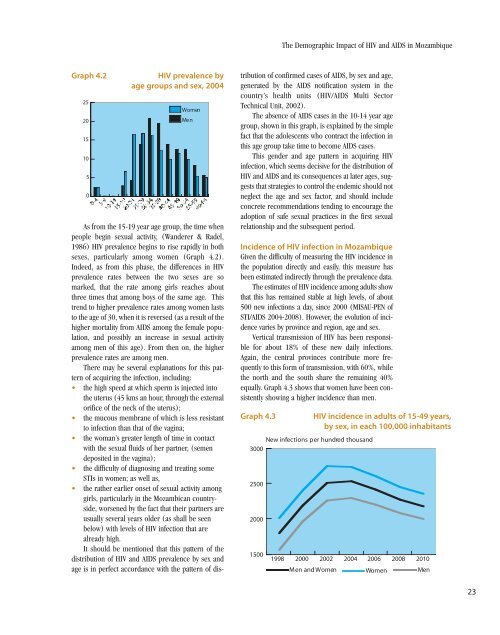Mozambique National <strong>Human</strong> <strong>Development</strong> Report 2007Graph 4.1Population affected %2015105019882000observed in Maxixe. In the northern region, theprovinces with the sharpest growth were Nampulaand Cabo Delgado.Sofala province has the highest percentage ofHIV infections. In this province, HIV infects one infour people aged between 14 and 49. In Inhambane,Cabo Delgado and Nampula the situation is at its leastserious. In these provinces the virus that causes AIDSinfects less than one person in ten.HIV prevalence rate amongthe adult population (15- 49 years)It is estimated that in 2004 there were about 1.5 millionpeople living with HIV and AIDS in Mozambique,60% of them women, and the remaining 40%, men.Projections of the evolution of the HIV and AIDSepidemic in Mozambique indicate that, if the historicpattern of evolution is maintained, without immediateand effective intervention, then the epidemic willcontinue to grow until 2009, when it will be stabilizedat around 17%, as a result of reaching a balancebetween HIV infections and mortality fromAIDS; that is, when the number of deaths per day isequal to the number of new daily infections.At regional level, 1 the projections show differentpatterns of growth, as illustrated in Graph 4.1As shown in Graph 4.1, the central region as awhole has been experiencing a rapid growth in theepidemic, and it is forecast that as from 2005 or 2006it will reach the phase of maturity or stability at around17 or 18%, particularly in Tete province, if effectivemeasures to prevent the transmission of HIV in thisregion are not implemented and/or strengthened.2002Projection of HIV prevalencein adults, 15-49 yrs, by regions20042006North Centre South20082010A more detailed analysis of the evolution ofprevalence at the Sentinel Sites of this region suggestsa mosaic of trends in the pandemic, with someprovinces showing a pattern compatible with themature phase of the epidemic, some requiring moretime for observation, and finally one, Zambezia,where the disease still seems to be growing sharply.Finally, the northern region, with little historicalinformation prior to the year 2000, shows the lowestlevel of prevalence in the country. But likewise,unless effective preventive measures are implemented,it is forecast that the epidemic in this region willcontinue to grow rapidly, until around 2009-2010,when it will tend to reach its mature phase at about15%. It should be noted that the projections forprevalence in this region could undergo variationsin the future as more information becomes available,though it is expected that in the coming yearsthey will remain lower than those for the south andcentre.In conclusion, the projections presented hereare only valid in the current context.As more data are collected over the years, andshould the preventive and therapeutic (ARV) measuresbe effectively implemented, the projections forthe pandemic’s evolution could undergo significantchange in the coming years. For example, in someprovinces, particularly in the north and inInhambane, the opportunity is still there to preventthe spread of the epidemic from reaching the samespeed as observed in most of the provinces south ofthe Zambezi River.It is also possible to “anticipate” the maturephases of some provincial micro-epidemics, so thatthey may be reached at levels lower than those forecastfor most of the provinces south of the Zambezi.Estimate of HIV prevalence by sex and ageAs may be seen from Graph 4.2, most children whobecome infected in the peri-natal period die beforethey are 5 years old, and few survive to their 10thbirthday. More than half of the children living withHIV and AIDS in Mozambique are estimated to diebefore their second birthday. After this age, thereopens the so-called “window of hope”, in which childrenare seen to be virtually free of infection until theage of 14.1 Because of scarcity of data on the epidemic’s historical evolution, and because it has not yet reached its mature phase in most of the country’s provinces,provincial projections would produce results that are not very reliable. For this reason, the projections are made by region, namely the South (Maputo Provinceand City, Gaza and Inhambane), the Centre (Sofala, Manica, Tete and Zambézia) and finally the North (Nampula, Cabo Delgado and Niassa).22
The Demographic Impact of HIV and AIDS in MozambiqueGraph 4.22520151050HIV prevalence byage groups and sex, 2004WomenMe nAs from the 15-19 year age group, the time whenpeople begin sexual activity, (Wanderer & Radel,1986) HIV prevalence begins to rise rapidly in bothsexes, particularly among women (Graph 4.2).Indeed, as from this phase, the differences in HIVprevalence rates between the two sexes are somarked, that the rate among girls reaches aboutthree times that among boys of the same age. Thistrend to higher prevalence rates among women laststo the age of 30, when it is reversed (as a result of thehigher mortality from AIDS among the female population,and possibly an increase in sexual activityamong men of this age). From then on, the higherprevalence rates are among men.There may be several explanations for this patternof acquiring the infection, including:• the high speed at which sperm is injected intothe uterus (45 kms an hour, through the externalorifice of the neck of the uterus);• the mucous membrane of which is less resistantto infection than that of the vagina;• the woman’s greater length of time in contactwith the sexual fluids of her partner, (semendeposited in the vagina);• the difficulty of diagnosing and treating someSTIs in women; as well as,• the rather earlier onset of sexual activity amonggirls, particularly in the Mozambican countryside,worsened by the fact that their partners areusually several years older (as shall be seenbelow) with levels of HIV infection that arealready high.It should be mentioned that this pattern of thedistribution of HIV and AIDS prevalence by sex andage is in perfect accordance with the pattern of dis-tribution of confirmed cases of AIDS, by sex and age,generated by the AIDS notification system in thecountry’s health units (HIV/AIDS Multi SectorTechnical Unit, 2002).The absence of AIDS cases in the 10-14 year agegroup, shown in this graph, is explained by the simplefact that the adolescents who contract the infection inthis age group take time to become AIDS cases.This gender and age pattern in acquiring HIVinfection, which seems decisive for the distribution ofHIV and AIDS and its consequences at later ages, suggeststhat strategies to control the endemic should notneglect the age and sex factor, and should includeconcrete recommendations tending to encourage theadoption of safe sexual practices in the first sexualrelationship and the subsequent period.Incidence of HIV infection in MozambiqueGiven the difficulty of measuring the HIV incidence inthe population directly and easily, this measure hasbeen estimated indirectly through the prevalence data.The estimates of HIV incidence among adults showthat this has remained stable at high levels, of about500 new infections a day, since 2000 (MISAU-PEN ofSTI/AIDS 2004-2008). However, the evolution of incidencevaries by province and region, age and sex.Vertical transmission of HIV has been responsiblefor about 18% of these new daily infections.Again, the central provinces contribute more frequentlyto this form of transmission, with 60%, whilethe north and the south share the remaining 40%equally. Graph 4.3 shows that women have been consistentlyshowing a higher incidence than men.Graph 4.3New infections per hundred thousand300025002000150019982000Men and WomenHIV incidence in adults of 15-49 years,by sex, in each 100,000 inhabitants200220042006Women20082010Men23
















